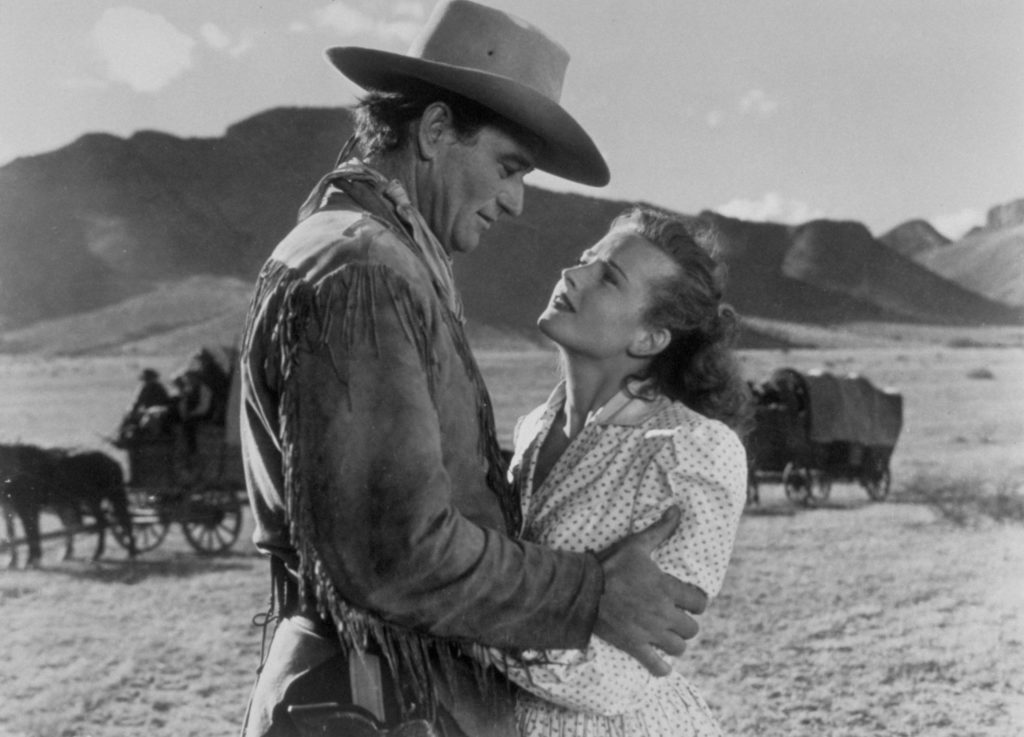I have always found the westerns of Howard Hawks to be sentimental and the westerns of John Ford more nostalgic by comparison. This juxtaposition is only necessary because in my opinion sentimentality over nostalgia provides a greater scope in the emotional content of the picture. To demonstrate, let us compare the two characters John Wayne portrays in the before mentioned films. In Ford’s Stagecoach (1939), Wayne plays the Ringo Kid, who for better or worse is a two dimensional character. The Ringo Kid has two sides; the naïve youth and the vengeful gunslinger, both are played up equally in Ford’s film. Whilst in Hawks’ Red River (1948), Wayne as Dunson has several dimensions and character archs. First, Dunson is the romantic working class pioneer, then after the murder of his lover, a bitter man of ambition, after that a desperate man, then he assumes the role of vengeful gunslinger. Within a decade, the archetype of western leading men had metamorphosed from two-dimensional to something resembling a human being. In comparison, the roles Wayne plays for Hawks is the much more engaging and posses a depth never quite achieved in Ford’s films till The Man Who Shot Liberty Valance, which lends such depth and humanism to both it’s principal characters played by Wayne again as well as James Stewart respectively. Thus in as far as one is making a character analysis within the films, Howard Hawks’ film is much more believable as well as epic.

But that is a point exclusive to character; narrative structure is a much different component. John Ford’s film and Howard Hawks’ film are primarily structured around a single trek with various stops along the way where characters develop or change. But it is Hawks’ film that within a prologue to the main story of the film makes way for added depth of character, as well as structure. The prologue sequence of Red River does its job well establishing characters and plot, but it exists some 15 years before the main narrative, and thus adds a scope in time to the picture. Where as the scope of Stagecoach is limited to but a few days.
The previous two points also lend themselves to Red River’s resolution, which by western standards is quite typical. It is the journey to such a resolution that sets the film apart. Red River makes good use of a large cast of characters and walk ons who articulate in interaction the complexity of the emotions and primary characters of the film over a long duration of screening so that closer ties are made with the audience as well as a new level of believability is achieved. Stagecoach is a film whose many components do not intertwine quite as believably, but rather depends upon the audience’s passion for the American western mythos, which sadly upon second and third viewing feels quite corny and plastic. And where humanism and plasticity are measured for worth in terms of how epic they are, it is surely not plasticity that will win when it is so limited.
That is not to say that the myth of the west is not at play in Red River, on the contrary. Red River’s primary narrative story arch is the fundamental building block of the mythos. Dunson is a self made man fighting to preserve his dreams in the land of promise, and Clift as Matt Garth is the son learning the lessons of honor and dignity, which are both essential western themes. It is simply that Red Rivermoves beyond the superficiality of the story’s surface, to the intricately nuanced character archs subverting it. This is a tactic which at that stage in Ford’s career as a director seems quite foreign, and that extends to his war films, especially They Were Expendable.
In terms of visual scope, Red River encompasses much more land and eclectic seasons, making an often-compelling visual palette, where Stagecoach seems often claustrophobic in its interiors and short sighted in the exteriors. The real scope of Stagecoach isn’t truly sensed until the climatic chase with the Indians, and even then the movement is so hurried that the languid splendor of the west is merely a backdrop. In terms of these comparisons of visual scope, one must also take into account the fact that most of Stagecoach was shot on a studio lot with matte paintings. While Red River was a film shot on many more locations though not completely escaping the trappings of a studio back lot.
All in all, one is left with merely opinion and taste. I prefer character and story to action and the plasticity that often accompanies it, and have criticized the two films that way. Red River, though still as clichéd as any Hollywood western of the 1940s, exhibits the epic of the west as I like to see it and in a film I consider much more mature and engaging than Stagecoach.
